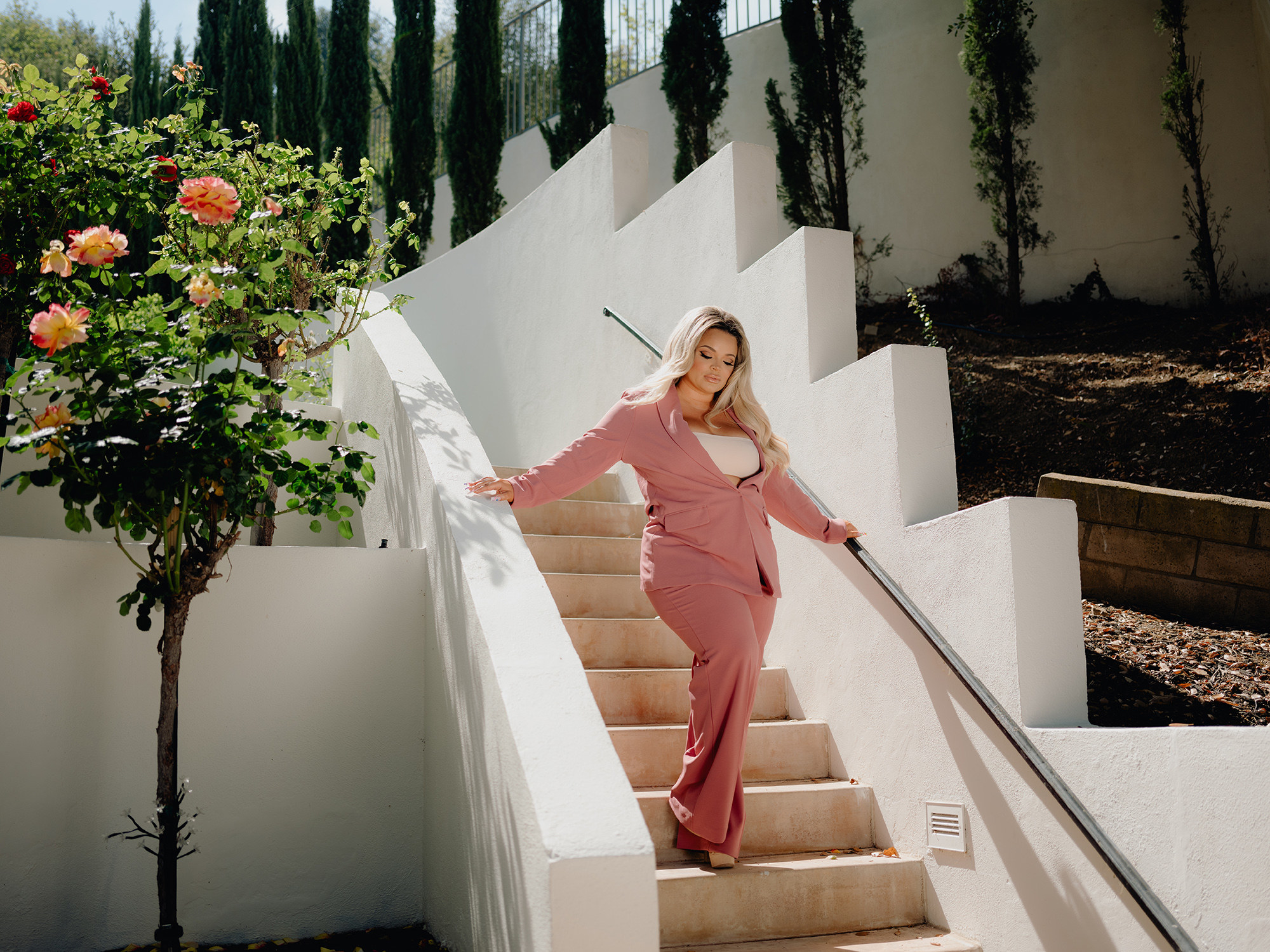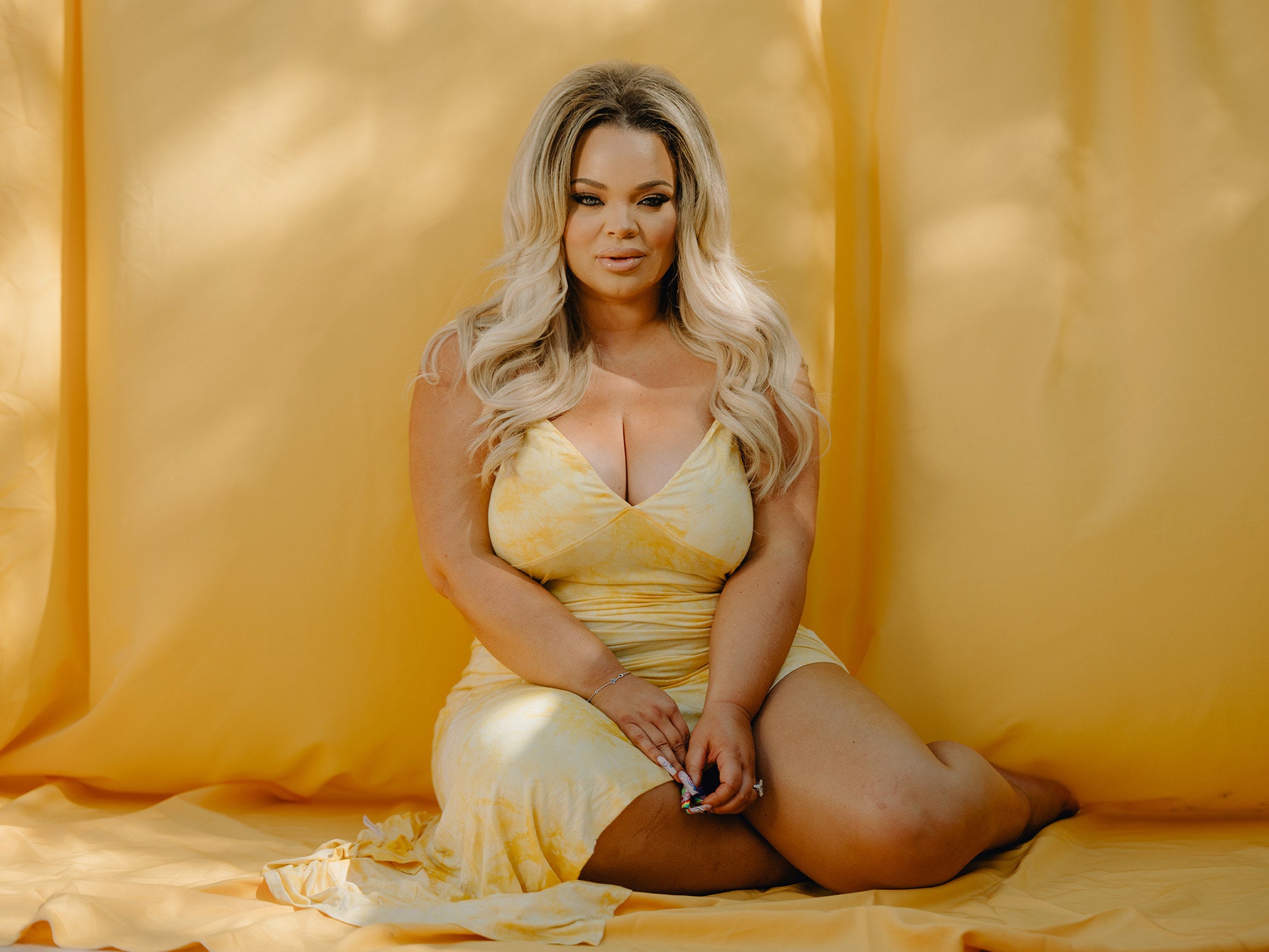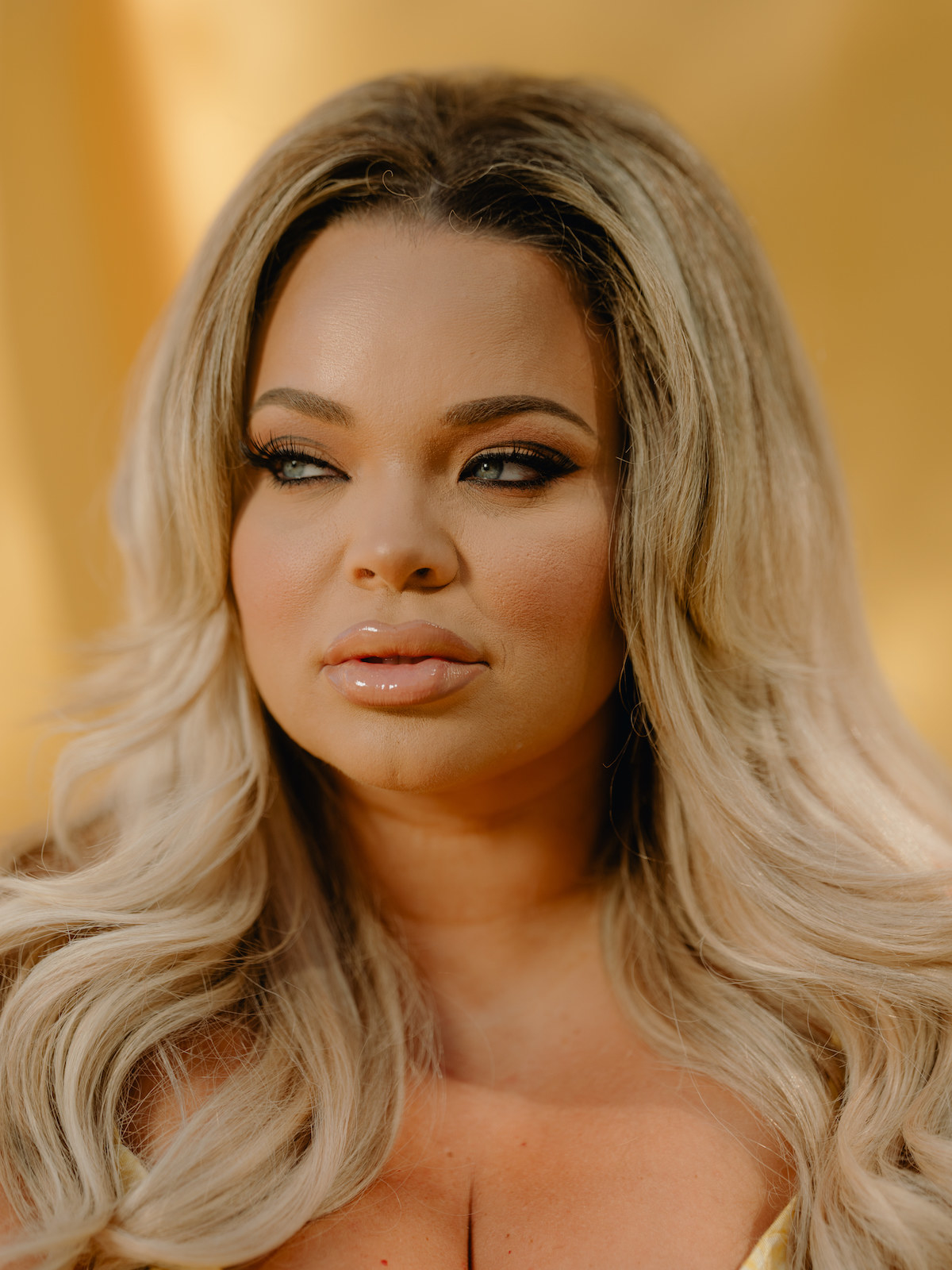After my Uber driver dropped me off at Trisha Paytas's 4-acre property, I immediately got lost.
I recognized a few of the custom luxury vehicles in Paytas’s driveway — including a half-million-dollar Rolls-Royce and a Bentley convertible in the same Barbie pink. After all, I’ve watched videos of the YouTube creator eating mozzarella sticks, head-sized burgers, and terrible salads in those front seats.
Perched at the top of a hill in Thousand Oaks, in a gated community with strict security and spotty cell service, the property was so sprawling that I was exhausted after climbing two sets of stairs. I lost time staring at the remarkable view and wandering around the pool and basketball court. (I’m told that Britney Spears lives in a nearby community, just on the other side of the hill.) When I finally found the front door, Paytas answered it wearing a matching shirt and shorts combo promoting their band, Sadboy2005, short French tips, a full face of glam, and their natural hair. Their eyes are the size of the Mrs. Potts teapot in their kitchen, the same blue as the LaCroix they took out of their drinks-only fridge while they led me through their house. (Earlier this year, Paytas came out as nonbinary and uses they/them pronouns.)
Trisha Paytas is rich. Unbelievably rich. So rich that I kept muttering “Jesus Christ” under my breath as they walked me through their acres-wide mansion and showed me their endless mountain of stuff. They told me with all their income streams, they make about $800,000 a month, a number that sounded so absurd I asked Paytas to clarify repeatedly. $800,000? A month? Eight hundred. Thousand? A MONTH??
But maybe that number isn’t surprising if you have a sense of how influential and prolific Paytas has been on YouTube for the last 15 years. Paytas’s primary YouTube account (they have two active accounts), blndsundoll4mj, has 1.9 billion views and just over 5 million subscribers. They’re far from the most popular creator on YouTube, but they are the face that launched a million memes.
How did Paytas get all those curious eyes glued to literally everything they do? The more mundane explanation is that they get involved in every known drama, every known trend, and every subculture on the internet. They make mukbangs, storytime videos, skits, shopping hauls, drama-commentary videos, TikTok dances, memes, travelogues, and for a brief moment, some surprisingly satisfying ASMR. Paytas is so unbelievably charming that over 139,000 people watched a video of them eating four hard-boiled eggs. “Are we seriously watching her eat 4 eggs?” wrote one commenter a year ago. “I guess we are.”

But there’s a better way to understand their runaway popularity. Paytas’s YouTube description simply says, “I’m Andy Kaufman.” A comedian, performance artist, and sometime wrestler in the ’70s and ’80s, Kaufman invented his own kind of anti-comedy. The audience was never really sure whether he was in on the joke, if it was supposed to be funny, or where his performance stopped and his real life began. Paytas loves the now-deceased (or is he) performance artist slash comic and seems to view him and his proto-troll persona as an inspiration for their own living performance. “The only troll I think in this world that did it right was Andy Kaufman,” they told me.
Paytas’s YouTube content has also been influenced by celebrities from the early aughts — those young, beautiful, blonde women who were perceived as airheads. (This is and was, it’s worth remembering, very false.) Paytas looks to Marilyn Monroe, The Girls Next Door, and Anna Nicole Smith (Paytas’s office is slated to be a kind of ode to Smith, complete with fuzzy pink walls), among others, for inspiration. “I always wanted to be dumb, you know, like Jessica Simpson. I never wanted people to hate me. So then all of a sudden when people hated me it’s like, Damn. That was not what I wanted,” they said. “That’s how I thought with my trolling too. I thought, I’m just dumb.”
Most of their success has come at great personal cost — collapsed romantic relationships, body dysmorphia, and extraordinarily cruel online abuse. They’ve been mocked for everything from their looks to emotional outbursts that they’ve recorded for YouTube. (A fair portion of the latter, Paytas said, can be attributed to their undiagnosed mental health issues and their past addictions.) They’ve also gained a reputation as an unreliable narrator who constantly trolls for attention and never learns their lesson. In fact, there’s an endless trove of compilation videos featuring Paytas’s most transparent grabs for clicks, like threatening to eat Tide Pods while wearing a paper bag on their head and rapping.
Paytas’s own audience has repeatedly rebuked them for their own content, like the time they created “Trishii,” a caricature of a Japanese pop star dressed in Ganguro girl fashion. “Obviously,” they said, “I wouldn’t do that now.” In a 2017 video, Paytas claimed to be changing their ethnicity to Black. They also posted a video of themselves using the n-word and have repeatedly been accused of cultural appropriation. There are so many examples of Paytas getting canceled for their own behavior — much of which Paytas attributed to “bad judgment” — but for what it’s worth, they seem reflective about the damage they’ve caused. “I’m embarrassed all the time,” they said. “I feel it all the time.”
“I’m embarrassed all the time.”
But Paytas told me they’re now done with the very thing that made them so internet famous — and rich — to begin with. “I admitted to trolling because I didn’t want to do that anymore. But I also think it was a psychological problem where I was doing it because I didn’t know who I was either.”
They also don’t really have to anymore. They’re successful, and their brand is a well-oiled machine that focuses on the brightly colored chaos of their life. And maybe because of that success, they seem to have attained a new kind of peace, too. “I really like my life, especially now,” they told me. “I’m so happy. It’s definitely a different time.”
I believed them.
Maybe that’s because the last couple of years have seemed to bring real growth for Paytas, or at least that’s what it looked like when I visited them at home in May. They’ve cut off ties with a few YouTubers known for their toxicity, namely their ex-boyfriend Jason Nash, his collaborator David Dobrik, makeup artist Jeffree Star, and the currently canceled Shane Dawson. Now, they keep a much smaller circle of friends, mostly people who aren’t on YouTube. Increasingly, they seemed like the voice of reason among melodramatic creators, especially on TikTok, where they often share their take on the internet’s latest feuds.
In 2019, they were diagnosed with borderline personality disorder, and more recently, schizophrenia. They got sober, and in 2020, became engaged to 43-year-old Israeli artist Moses Hacmon. (Hacmon is also the brother-in-law of Ethan Klein, who was, until very recently, Paytas’s cohost on the wildly popular podcast Frenemies.) They’re now in the process of converting to Judaism. The engagement happened at California’s Imperial Sand Dunes; the couple wore what appeared to be Evil Jasmine and Jafar cosplay. In their kitchen, Paytas showed me their 9-carat, marquise-cut diamond engagement ring, which is the size of a knuckle. It was fastened to their finger with a $2 piece of plastic. “It’s too big for me, so we just bought that off Amazon,” they said.
I had a good conversation with Paytas, one that seemed to prove they had indeed turned a corner in their personal and professional life. I was sure they were a calmer, more centered person after so much struggle and so many people wildly — and sometimes intentionally — misunderstanding them. But a month after our interview, I wrote a profile about another YouTube influencer and Paytas tagged me in a series of disgruntled tweets, which launched a few thousand people my way on Twitter, Instagram, and in two of my email inboxes. I ended up having to go private on Instagram and deactivate my Twitter. It’s been more than a month, and I’m still managing the fallout. Not long after, they also torpedoed themselves from their Frenemies podcast, one of their most successful projects, over a squabble with Klein. And so yet again, Paytas seems to be back where they started, a semi-ironic entertainer facing an audience that doesn’t know if they’re supposed to laugh at Paytas, or with them.
When I first met Paytas, I thought I was laughing along with them, enjoying the blips of (sometimes) harmless chaos they left in their wake. A few months later, I now realize exactly how much damage they can cause.

When I arrived at their home, it was the day before their 33rd birthday and Paytas said they needed to get organized fast, because, according to them, “Cribs is coming in, like, July, so we’re really trying to rush and get things done.” Paytas took me on a tour and their stuff was everywhere: a pair of snakeskin boots on the coffee table, piles of wigs on the floor, tons of Beetlejuice ephemera. Haphazardly stuffed in a bookshelf nearby were mini backpacks decorated with Sleeping Beauty and the couple from Up, and a Baby Yoda purse that obscured a blue ombré duffle featuring the Louis Vuitton logo painted in clouds. (It retails for $2,810 and is currently out of stock.) They seem to own two of everything — every shoe, every makeup palette, every octopus Squishmallow — and yet the display still barely made a dent in the $3.8 million house they recently bought with all that YouTube change.
Their YouTube income — just one of their income streams — fluctuates wildly: “I was making, at the height of it, $250,000 a month, to like $0, to maybe $6,000 a month. Pretty much all of 2019 I made $6,000 a month,” they said. “I’m up and down with it, but it is home.”
In 2017, Paytas’s channel was completely demonetized for five months after they said they inadvertently participated in “a scam” with a company called StyleHaul. “It was a company that would help people get brand deals, but they would take a percentage of your ad revenue,” Paytas said. They offered them a premium for participating. “If I made — let’s say a basic number — $10,000 a month, they were going to give me $120,000 a month. That part wasn’t a scam. I was getting that at the beginning.” The trouble came when the company started signing other smaller creators, taking 40% of their ad revenue, and redistributing it to larger creators like Paytas. (StyleHaul shut down their US operations in 2019, and their former executive was charged with embezzling $22 million from the company.)
They’ve since expanded their empire, including a merchandise line for Sadboy2005, which has sold out multiple times over. (Take a look at their website if you need a pair of $85 sweatpants that say “it’s ok to be sad.”) There’s also skincare — their Miracle Elixir Collection, a bundle of serums, toners, and creams that costs $160, which launched in June. And until recently they were getting income from Frenemies, which has nearly 20,000 ratings and 4.8 stars on Apple Podcasts, and a YouTube following of more than 3 million. They’ve released multiple singles and EPs, including “I Love You Moses,” “Fat Chicks,” and a cover of “What Dreams Are Made Of” from the Lizzie McGuire soundtrack. They have sponsorships with companies ranging from Fashion Nova to the sex toy brand Adam & Eve.
Their sister, Kalli Metz, helps run their extremely successful OnlyFans account, where for just under $5 a month, you can view a plethora of Paytas’s adult content. “My sister does my OnlyFans for me in exchange for, like, a shoutout to her OnlyFans,” Paytas said. And even though, according to Paytas, they’re no longer making any new content for the site and are simply repurposing old content for a fee, they’re still making a lot from it every month. “Maybe, like, $150 [thousand],” Paytas said.
Kate Spades are tossed around the house like Kleenex.
Paytas is unrepresented, so there are no agent or management fees — and they respond to their own press emails, too. But they do have a $13,000 monthly mortgage that they split with Hacmon. Around $100,000 goes to taxes every month — in their mid-20s, they said they made the mistake of not paying their taxes, which left them completely broke when the IRS came knocking. Their hair, face, and nails are professionally done three to four times a week. That’s $450 for hair, $450 for makeup, and they have the same nail tech as Kylie Jenner, which all adds up to a few thousand dollars a week. One of their music videos might cost $100,000. They only travel first class, which they did even when they were broke.
They also have a breathtaking weekly shopping habit. As I looked around Paytas’s house, I found myself saying a sentence I never thought I would utter: “Is this an Adam Sandler purse?”
It was. On their kitchen table was a handbag printed with the comedian as his Israeli character in You Don’t Mess With the Zohan. I asked them how much they think they spend when they shop. “Maybe $5,000 a week. And if I splurge, like, my Birkins can go up to like, $60,000 or $80,000,” they said. “And my jewelry, it goes up to $80,000.” Paytas isn’t sure how many Birkins they own — maybe eight or nine. A sales associate from Louis Vuitton texts them about new arrivals and simply charges the card the store has on file when Paytas wants something.
Hacmon is currently designing a good portion of their furniture, including a custom-made Prince of Egypt–themed bed that’s so tall it requires stairs. Paytas said the living room will have a mermaid theme, and there are already some toddler-sized seashells next to the fireplace. The kitchen is Miami Vice–themed, and features a disco-tiled Versace table with matching chrome seats. It also includes two ceiling-height cabinets full of Swarovski-bedazzled vessels: a champagne bottle with a crystal Chanel logo, endless Starbucks cups, a sparkling Nutella, a glittering bottle of Febreze.
One day, when they have a baby, the nursery will be Up-themed. And if you stay in Paytas’s guest room, you’ll be sleeping in a replica of one of the beds from Schitt’s Creek. They also have mugs and signs from the Rose Apothecary store and Rosebud Motel merchandise. “What happens if you don’t care about Schitt’s Creek in a year?” I asked. “People say that, but my last room was the Beetlejuice bedroom and we’re doing a Beetlejuice dining room here,” they said. “I don’t get sick of a theme.”
I asked if they ever contemplated the sheer volume (and cost!) of all the eclectic things they own, from the endless designer bags (Kate Spades are tossed around the house like Kleenex) to the bathroom’s hand towels embroidered with “Be Our Guest.” “Only when people point it out,” they said, waving me through a hallway leading to another suite of bedrooms. “Honestly, I just think everybody has stuff like this.”
And yet it’s still seemingly not enough. They dream big, mostly in the Notes app on their phone, in a tab called “Upcoming Money,” where they list all the things they still want. “Another Birkin, a golf cart, 4th of July party, Halloween party,” they said. “These are all the places [to visit]: Maldives, Israel, Italy, Switzerland, Prague, giraffes in Africa, Tokyo, Maui.” They want two more cars, to make two more music videos, to pay off their credit card, to buy a house in Palm Springs, Vegas, and Hawaii each. And then there’s a section just for their mom, Lenna. “I love spending money, I spend money on people. I love taking people on trips. I’m a purse person, so I’m like, ‘You want a Birkin?’”
All that cash is nice, but it doesn’t seem to have ever been Paytas’s primary goal. What they always wanted, first and foremost, was to be famous, at any cost. “I never sang or danced or acted, I was just like, I want to be famous,” they said. “I have some pride about it. I did that. I was the perfect troll.”

Because Trisha Paytas trolls so much on YouTube and is very good at it, their audience often accuses them of lying. It happens constantly: When they cry over a breakup or reveal information about another influencer’s allegedly bad behavior, it takes a while for their viewers to accept the information, believing it’s just another example of Paytas blowing something out of proportion for attention. (In a lot of cases, Paytas was right and was telling the truth, but that seems to matter very little to their least generous viewer.)
Accusations of them being a liar have come up in their life often, and not just when it comes to YouTube tea or fighting it out in the comments. It started when they were a kid, growing up in Illinois. Paytas said they made complaints about three teachers who had harassed them, sometimes physically. “Kids would see it too and try and validate me, and the principal would either not believe me, the teacher would call me a liar,” they said. “So from an early age, I was just like, People just don’t believe me.”
At 18, they graduated high school and flew to Los Angeles the next day. (Their father lived in California, but didn’t approve of the move.) They said they started doing drugs almost immediately. “I was living in this apartment in Hollywood with, like, no doorknob. That was the first time I got hospitalized due to drugs,” Paytas said. “I basically passed out for three days. My dad found me. I was in urine and feces in my apartment. I think I got drugged. I got robbed. I was with a guy that gave me drugs all the time. And he was injecting me.”
Paytas isn’t exactly sure what they were taking — they tried heroin for the first time when they were around 19 years old, so they’re pretty sure it wasn’t that. “And then my pill addiction, that came about when I started doing plastic surgeries. I started getting Vicodin and stuff,” they said.
In their early 20s, Paytas did offline sex work. It was unglamorous and sometimes scary; they told me they didn’t like doing it and said they were assaulted repeatedly. There’s still a lot of fear wrapped up in talking about the abuse they faced. “It’s more like, It’s not me. That’s not my life,” they said. “The time that I did sex work, that’s just like a story I tell.” Now, they keep tabs on people who have hurt them — even fellow YouTubers. “You want to see that you have control of what that person’s doing, and where his actions are, and making sure that person doesn’t come near you.”
In February 2019, Jason Nash broke up with them and, according to Paytas, strung them along for a few months. (Paytas says Nash dumped them because his YouTube collaborator and friend, David Dobrik, told him to, because he said Paytas was a career drain. Members of Dobrik’s Vlog Squad are currently being accused of rape, assault, and providing alcohol to minors. Dobrik and Nash did not respond to multiple requests for comment, but Dobrik did post this apology to YouTube in March.)

Around the breakup, Paytas told me their drug use accelerated, including Vicodin, Percocet, meth, and hallucinogens. During the drawn-out breakup, they would call Nash while doing drugs, asking to see him. One time, they ran around his neighborhood naked. On Feb. 5, 2019, the night of their anniversary, Paytas said they were put on a 5150 hold, a 72-hour involuntary psychiatric hospitalization. On their birthday in May 2019, they went to Nash’s house after getting high. “I don’t really know what happened. I blacked out, obviously. I think I drove my car to his house, crashed it, threw a brick in his house.” After this, they went to another psychiatric facility. (Nash did not respond to a request for comment.)
They made a YouTube video about the experience of being in a psychiatric facility, playing show-and-tell with their admission paperwork and the clothes they had been wearing. “I almost reverted to a little kid. You’re basically trapped like you are as a child,” they said in the video. “That was pretty traumatizing.”
Paytas told me these stories either very matter-of-factly, or sometimes with a chuckle. “Crazy,” they said, mostly to themselves.
The end of 2019 marked the last time Paytas used drugs. In the lead-up to that, Paytas had been posting videos that seemed not chaotic but rather radically honest. They posted about “everything wrong with the VLOG SQUAD,” taking aim at Dobrik and Nash in earnest after years of keeping fairly quiet, apart from some eating shows and videos that felt like watching therapy sessions.
Then, they said, they met a man who stayed at their house for a 13-day drug binge. “I didn’t post. It was my longest time not posting,” they told me. Paytas said they used cocaine, meth, heroin, MDMA, mushrooms, and possibly crack. “For a good month after he left, I thought my house was floating. I thought my house was not real,” they said. “It was really scary.” They’re now sober. “2019 was just the year of drugs, for sure.”
Paytas has commodified all of this behavior, along with the fallout. High or not, they’ve made videos in the middle of what looks like a breakdown, often crying and screaming, saying ugly things; these videos are almost always monetized. In fact, one of their trademark moves is addressing a scandal or making amends by posting a series of videos and including ad breaks on all of them. Paytas knows that these kinds of dramatics, be they sincere or trolling, can result in sizable income spikes. “I think that’s why I did it for so long,” they said.

Take, for example, a minor dispute they got into with Charli and Dixie D’Amelio, two prominent TikTokers who had their first mini scandal when they were rude to a chef about his cooking. Paytas called the sisters entitled. “My TikTok went from making, like, $100 a day [to] making $16,000 a day when I was talking about Charli and Dixie and they were talking about me,” they said. “I would not do it anymore for views or money. It’s just so much anxiety.”
Paytas has suffered and profited from plenty of controversies, including major scraps with some of the most influential and legitimately powerful YouTubers. They’ve fought with Nash, Dobrik (who they allege hid in their hotel room to scare Paytas while they were naked), Jeffree Star (“I think he’s just a mean girl. He just has a bad personality”), Shane Dawson (“I’ll never talk to him again”), and Gabbie Hanna (Paytas declined to comment on anything having to do with her), among others. The result is that Paytas now tends to avoid industry events and fellow creators. “I’m not a person that likes to be around peers,” they said, adding that they’re still friendly with old-school YouTubers Colleen Ballinger and Joey Graceffa.
There’s also the matter of Paytas’s mental health, which they said has only recently settled into something manageable thanks to a combination of medication and multiple forms of therapy including dialectical behavioral therapy classes, an eating disorder specialist, a psychiatrist, cognitive group therapy, and a therapist who specializes in gender and sexuality. “I never went to therapy before,” they said. “I’ve never been in a ‘good’ place. I’ve been in ‘OK’ places. I think this for sure feels like it. I put in work on myself.”
Some of their viewership is still suspicious of this new-and-improved Paytas.
But some of their viewership is still suspicious of this new-and-improved Paytas. Even their announcement that they were nonbinary was met with some derision by their own audience, convinced that this was yet another troll. In one 2016 video, for example, Paytas claimed to identify as a chicken nugget. “I’m a chicken nugget, and that’s what I’ll identify as,” they said. “I don’t think I should be discriminated against, and I don’t think I should be talked down upon, and I don’t think I should be called crazy for identifying as such.”
I asked Paytas about the video and their intention behind it. “I think I was just out of my mind,” they said, adding that they were using drugs at the time, which in hindsight feels obvious. They seem disoriented, profoundly depressed, and close to passing out. Back then, the video seemed like another example of Paytas baiting their audience into outrage; now, with added context, it reads like a moment of recorded fragility that has nothing to do with their gender identity.
In 2019, they posted a video claiming to be a trans man; that video was taken down when they came out as nonbinary. For some of Paytas’s audience, it was unclear if that claim was a troll or just the result of someone not having the appropriate language for their gender identity. “I love when [people] refer to me as they/them,” they told me. “I like being she/her when it comes to my YouTube persona. But they/them, I think, is awesome.”
When we spoke, Paytas did seem healthier and happier. There have been no outward displays of stress in their relationship with Hacmon, a marked departure from their other very public, chaotic former relationships. Hacmon met Paytas through his sister, Hila, and brother-in-law, Ethan Klein. They’re now planning three weddings: one in the Four Seasons in LA, another in Israel in January, and then a third (“more for pictures”) in Maui. “It’s only one time you get married so it’s like, ‘Let’s just go full out,’” they said. “Or three times.”

Hacmon is a man of remarkably few words, but he clearly loves Paytas. “Once we started dating, I knew it,” he told me. “She’s one of a kind.” (Paytas told me they were comfortable with Hacmon and family members using she/her pronouns.) Hacmon is almost religiously private, and there’s very little information about him available online. He knows what boundaries to create with Paytas and their rapt audience. “If there’s something I don’t want to be public about, then I just don’t say it,” he told me with a smile. “I just won’t tell her.”
“What?” Paytas said, turning around to look at their fiancé, bemused. “Really? What are you hiding from me!”
Their YouTube channel has also begun to change. The shift I’ve noticed the most is fewer torturous mukbangs. Back in the day, Paytas would order enough food for an army and try to clear through it, sometimes as much as 10,000 calories in a day. It was compelling viewing — a Pizza Hut video featuring Paytas grazing on a few pizzas and pastas has 7.6 million views — but the truth behind all those videos is grim. “There’s videos of me just drinking water for 10 days and showing how much weight I lost. I don’t do that anymore, and I don’t gorge myself to the point where I feel sick,” they said. “I would just not eat for, probably, a week, and then I would binge Friday through Sunday.”
Paytas’s binge eating — and their willingness to bring an audience into it — was part of a larger constellation of body image issues they said has plagued them for most of their life. In 2017, they got liposuction on their stomach, a process they documented (and monetized) in full. When the weight came back, it became another way for their viewers to criticize Paytas — they were eating too much, they didn’t accept themselves, they got surgery, they didn’t get the right surgery, they needed to lose weight, they lost too much weight too fast. Their audience treated Paytas like a freak show while refusing to admit that they liked watching them suffer.
Paytas says that although they’re now at their highest weight, they’re the happiest they’ve been with their body. “I have an acceptance of my body. I have an acceptance of how I want to eat,” they said. “I’m just kind of cool where it’s at.” Paytas’s mother, Lenna, who eventually moved to Los Angeles to join two of her three children, has been influenced by their radical acceptance. “I’ve always thought of dieting my whole life, and she’s made me change my thinking. Just accept yourself!” Lenna said. “She has a very powerful message for girls and guys.”
Paytas and their mother are close, and Lenna has been the most present force in their life, on- and offline. Paytas told me that as a single mom, Lenna worked four jobs to keep the family afloat. “My mom, up until I was like 24, was giving me money. My mom was always bartending and just gave me all the money she had,” Paytas said. “Then, when she couldn’t work because of cancer and neuropathy, that’s when I was like, ‘Oh, just let me pay the rent.’ It was like $3,000 and I was making $800,000 [a month].” According to Lenna, Paytas’s level of fame and wealth barely registered with her until recently, when Paytas bought her a 2,000-square-foot home in a gated community nearby.
Yet throughout all the controversies and challenges, Paytas has seemingly shared more with their audience than their own family. Lenna told me she actually learned a lot about Paytas’s life from watching their YouTube videos. Even now, Lenna and Paytas had yet to have a conversation about their history of addiction or their mental health. “I don’t know. Maybe we should be more open,” Paytas said, holding their mom’s hand.
“She hid a lot from me until later,” Lenna said. “And then I knew, and I’m like, ‘that would’ve broken my heart, had I known some of the stories.’”
“I don’t talk too much to my parents. My mom’s just pure,” Paytas said. “Like, yesterday, Ethan was asking, ‘Yo, your daughter never told you about the time a candlestick was shoved up her ass?’ And it’s like, I don’t talk to my mom about these things!”

Last spring, Paytas did an interview with New York Magazine, effectively saying the same thing they told me: They were done trolling. “I thought, like, I’m not really talented or anything so maybe I just need to try and offend as many people as possible to get money,” they said at the time.
In the last year, viewers have started to see Paytas as a kind of underdog hero within the YouTube community, after years of being one of the most hated creators. People really started to like them — their TikTok comments had become a steady stream of young people who grew up with Paytas on their phones, wondering out loud, “Wait, do I love Trisha Paytas now?”
But that goodwill run ended when they got in a fight with their Frenemies cohost, Ethan Klein. On a June episode of the show, Paytas and Klein argued about how their money is split between the two of them, Paytas’s ideas for the show allegedly being shot down by Klein, and why Paytas gets no say over who they hire (Klein suggested they weren’t a part of the production team). The fight spiraled: Paytas walked off the show after making some comments about how they didn’t like the crew. Soon, Paytas announced they’d be quitting Frenemies for good, just as it was really taking off. While Paytas has walked out on the show or threatened to quit more than a few times, this exit seems to have stuck.
“As a friend, I have come to love and appreciate Trisha. She’s one of the funniest people I’ve ever known,” Klein said in a solo episode soon after the breakup. “I don’t know what more humanly I could’ve done to prevent this from happening. I feel like I have tried to accommodate her in every possible conceivable way to make this as comfortable, as equitable, I’ve been as fair as possible. She disagrees with that.” Meanwhile, old texts Paytas sent to Klein went viral, ones where they called Klein (who is Jewish) “Jewy” when they were discussing an earnings split. Paytas has since apologized while denying that the language was antisemitic. (Klein did not respond to multiple requests for comment.)
Over the last month, Paytas has posted three since-deleted monetized videos addressing their fight with Klein, thus creating yet another internet scandal ouroboros. In one TikTok, they joke about how thrilled they are that the internet hates them all over again. In another, they literally run away from demands they apologize to Klein.
From the day I crossed the threshold into Paytas’s home, I’ve been pulled into the undertow of the kind of YouTube fights I’ve watched for years.
In the public discourse, Klein is the victor in their fight. Paytas’s mentions have been filled with people demanding that they apologize and return to the show, calling them foolish, claiming that Paytas did this because they’re jealous of Klein and his wife (Hacmon’s sister), Hila. (Hila declined multiple requests for comment.) Some argue that Paytas was just too uncomfortable with comfort and needed to find a way to self-sabotage.
Around the same time as their breakup with Klein, I wrote a profile of one of Paytas’s nemeses, Gabbie Hanna. Hanna and Paytas had been in a fight for years, stemming from a rumor that Paytas believed Hanna started. Hanna came up in the course of our conversation, but Paytas asked that I keep those comments off the record in both this profile and the one I wrote about Hanna. (I did.) Ultimately, Paytas didn’t even want their name to be mentioned anywhere near Hanna's, an impossible request — a lot of Hanna’s online fame is, at this point, tied up with her fights with Paytas. Paytas tweeted cropped portions of our emails that made it seem like I had agreed to keep them entirely out of the article, which I had not. For weeks, Paytas’s most staunch supporters have been sending me doxing threats, suggestions I kill myself, demands that I be fired, racist jabs about my name and appearance, and suggestions that I could be sued for...actually, I’m not sure what. My Instagram DMs, Twitter replies, and email inboxes are still filled with them. Despite Paytas's fury over being associated with Hanna in any capacity, they did recently go on Tana Mongeau’s podcast, Cancelled, and once again publicly discussed Hanna and their ongoing feud.
Last week, I contacted Paytas for final comment and fact-checking as part of the process of running a profile like this. They responded: “I have zero respect for you as a journalist after I asked you to omit me from anything Gabbie related. Please kindly do not contact me again.” I sent one more email to them with detailed fact-checking questions.
Early Friday morning, they posted a new video to YouTube titled, in part, “ENEMIES #3.” In it, Paytas reads out loud from my fact-checking emails and responds in real time. “You conniving little snake rat face,” they said. “You disgusting little rat. You should not get to talk to another human being as long as you live. You are the bottom of the barrel scum pig of the universe.” It was, to put it mildly, a starkly different Paytas from the one I met in May.
Initially, having them lash out was frustrating because I think they’ve built an incredible — if flawed — career. I’ve been watching Paytas since I was 16, and even when they faltered, I believed in their redemption. It’s why I wanted to profile them in the first place.
But from the day I crossed the threshold into Paytas’s home, I’ve been pulled into the undertow of the kind of YouTube fights I’ve watched for years. I’ve seen Paytas activate their millions of followers in the past, and it feels profoundly destabilizing to not know if I’m being trolled — merely part of this week’s Trisha show — or if this is something else altogether.
When I was with Paytas in May, I asked them, “If you start trolling again, what should we, as your audience, say to you?”
“I don’t think I ever will,” they said. “It’s totally fine if people dislike me for something I did in my past. Understandable. I did it for money, and I got my money, and that’s it. But over time, I think people have seen like, Oh, she actually has changed.”
Andy Kaufman was a comedian, but he hated it when anyone called him one. “I have never told a joke,” he used to say. “My only promise is that I will try to entertain you as best as I can.” Kaufman’s claim was, literally, unbelievable, but he was a performer through and through. He never let the mask slip — or rather, there was no mask. That was just who he was.
Decades after his death, people are still desperate to understand Kaufman in some intimate way. I suspect Paytas’s audience has spent a good chunk of their lives wanting the same thing: to figure out what they’re about, who they really are, what they’re like beyond the performance. There will likely never be a satisfying answer, but that doesn’t matter.
We’ll all keep watching anyway. ●

